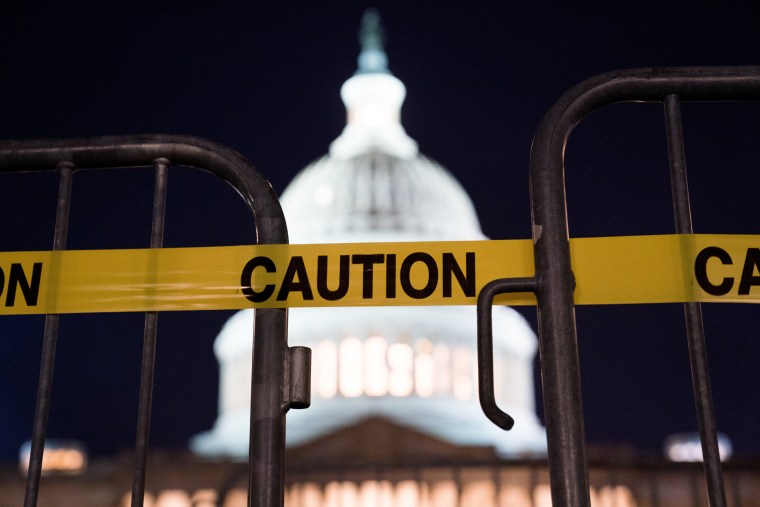WASHINGTON — With the partial government shutdown now nearly assured to be the longest in modern political history, we’re still at a standstill. But rather than finding a way to compromise their way out of the mess, it’s starting to look like both sides are simply calculating how much more pain they can withstand.
After President Trump walked out of a meeting yesterday with Chuck Schumer and Nancy Pelosi and called it “a total waste of time,” a resolution seems further than ever. And although there’s a trickle of Republicans breaking with the president on opening the government, the GOP generally seems to be sticking with their leadership for the moment despite private worry that theirs is the more untenable position.
Why? Check out how Republican Rep. Tom Cole of Oklahoma framed it in an interview with our colleague John Harwood: “Pelosi and Schumer cannot obtain absolute victory unless we give it to them. As much as I detest government shutdowns, I do not think we will. And I do not think we should.”
So, it sure seems like the choice GOP lawmakers see is: Stick with Trump, or be branded as an ally of Chuck Schumer and Nancy Pelosi. If it’s really that binary, we really are stuck.
But if the question is who can withstand more pain when it comes to political pressure and public opinion, all the signs we’ve seen (polling on the shutdown/wall, the midterm scoreboard, Trump approval), point to Democrats having the upper hand.
Another reason for the impasse: Relationships matter
It may sound like an old-fashioned sentiment, but one reason for the ongoing impasse is that the relationships between the negotiators are either nonexistent or have broken down. The Obama shutdowns were ultimately solved because Mitch McConnell and Joe Biden had a rapport that allowed them to hammer out a compromise. Does anyone think that Mike Pence and Schumer/Pelosi have that same relationship?
Republicans also badly misread Nancy Pelosi with their assumption that she would eventually be willing to cave on the border wall. Our point to any congressional Republican bewildered that she’s unwilling to give in? Remember how hard it was for the GOP to compromise with Obama, knowing the incoming fire they’d take from the base?
Remembering Trump’s “Art of the Deal” pitch
With the negotiations still at a standstill, it’s worth remembering how much Trump’s deal-making prowess was a central argument for his candidacy.
“I've watched the politicians,” he said in his announcement speech in June 2015. “I've dealt with them all my life. If you can't make a good deal with a politician, then there's something wrong with you. You're certainly not very good.”
“Coming from the private sector, I know how to negotiate. I do deals,” he told an audience in Iowa in January 2016.
And during a debate in March 2016, asked about his plan for a border wall, Trump said this: “There's always give and take. There's always negotiation. And the best negotiator that knows what he's doing will make a great deal. But we need give and take in government. If you don't have give and take, you're never going to agree on anything.”
On Day 20 of a shutdown over the wall, what exactly does that give and take look like from the White House?
Rosenstein will stay until Mueller’s work is done
Yesterday, we learned that Deputy Attorney General Rod Rosenstein plans to depart DOJ after new AG-nominee William Barr is confirmed.
And our own Pete Williams adds this important timing nugget: “A source close to Rosenstein said he intends to stay on until Mueller’s investigative and prosecutorial work is done. The source said that would mean Rosenstein would remain until early March. Several legal sources have said they expect the Mueller team to finish its work by mid-to-late February, although they said that timeline could change based on unforeseen investigative developments. The source said once Mueller’s work is done, the special counsel’s report to the Justice Department would follow a few weeks later, and Rosenstein would likely be gone by then.”
Yes, there’s the immediate crisis of the shutdown for President Trump. But as much stress as this moment may be putting on his administration, it’s a distraction from a Mueller report that’s looming perhaps sooner than anyone expected.
Steyer won’t run after all
After giving plenty of indications that he planned to run for president — including hiring staff and scheduling an announcement event in Des Moines — billionaire Tom Steyer said he WON’T run after all and will instead “spend 100% of his time and energy focused on removing Donald Trump from power.” Steyer says he’ll pump $40 million into efforts to impeach Trump instead.
The path for Steyer was always a question mark. Sure, it’s a heck of an advantage to have nearly unlimited personal resources and an extensive email list, but the Democratic Party base also doesn’t seem too keen on billionaires running for president these days. (Don’t forget Elizabeth Warren’s shot at them last week.)
Out of the race, though, Steyer may present a bigger question for the Democrats who do jump in. How do you deal with $40 million of pro-impeachment spending if you’re not sure you want to weigh in on impeachment yet?


